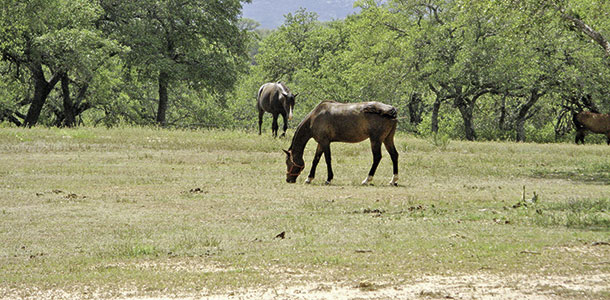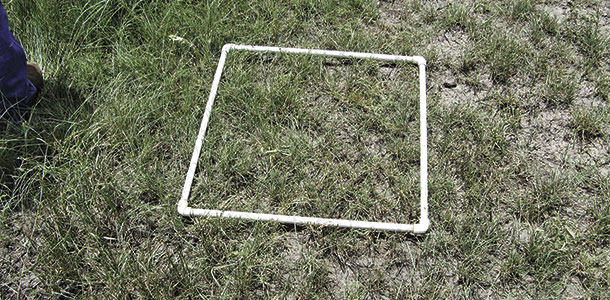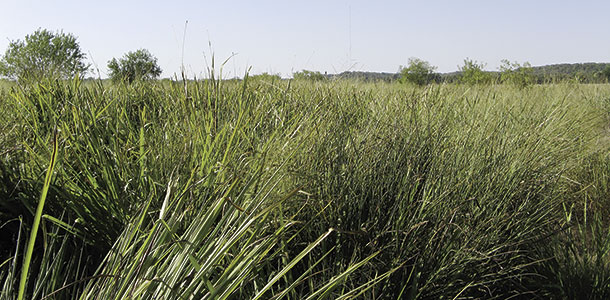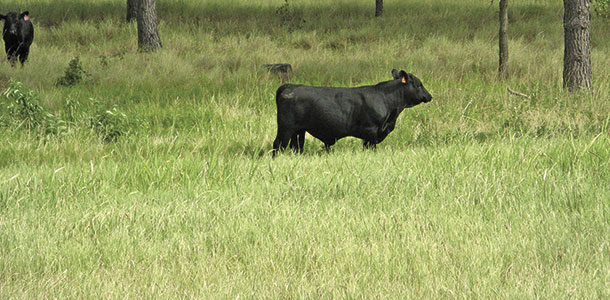Managers must learn to produce their agricultural products with less water in order to survive. In this article, conservation of forage through proper stocking rates is explored as an additional method of surviving drought.
The biggest detriment to forage production on pastures is overgrazing. When forage is grazed to the ground, leaf material required for manufacture of carbohydrates is removed. This makes it very difficult for plants to regrow foliage, resulting in a very slow recovery of pastures.
Carbohydrates are manufactured in plant leaves through a process of photosynthesis whereby light energy from the sun is used to make sugars and starches from chlorophyll. The starches and sugars are necessary for the plant’s functions and growth.
Perennial plants store carbohydrates in their roots and crown at the end of the growing season for restarting growth at the beginning of the next growing season. In overgrazed pastures, perennials are constantly required to draw from carbohydrate reserves to produce new growth.

Once the reserves are depleted, the plant dies. This is why it is important to know when to destock to avoid overgrazing.
Dr. J. Alfonso Ortega, with the Caesar Kleberg Wildlife Research Institute, Texas A&M University – Kingsville, says, “The three most important variables to monitor in range management are rainfall or moisture, quantity and quality of the standing forage crop, and animal body condition scores. Monitoring these variables and establishing triggers for each of them will help to be proactive when making management decisions rather than reactive.”
Trigger 1: Rainfall
It is important to measure and record daily rainfall on your land because it can be different from ranch to ranch and may vary within the property. The amount of annual rainfall has a big impact on forage production, but the time of occurrence has a greater influence.
Learn when rainfall usually occurs in your area and how much can be expected. If less than the expected amount is received, you have the first trigger for destocking. There are a couple of ways to destock: reducing the number of animals on the pasture by culling or moving some or all of the cattle to a different pasture with sufficient forage.
“Since forage production is not uniform through the year, it is important to determine the months in which it occurs,” Ortega says. “In South Texas, close to 50 percent of the forage production potential for the year occurs from March to May; therefore, rainfall received from January to May needs to be monitored and analyzed to determine if there is enough moisture for pastures to grow.
If we don’t receive at least 5 inches of properly distributed rainfall in Kingsville from January to May, we know plants are not going to reach their potential productivity. We know this even before estimating forage production. Reduced rainfall is the first alarm.
“A similar situation occurs during September and October when about 23 percent of the annual forage production occurs,” Ortega says.
“Accumulated rainfall from August to October is the primary factor affecting fall forage production. The first red flag that could trigger a destocking decision is the amount and distribution of rainfall occurring at least a month before and during the periods when maximum forage production occurs. Each rancher should determine the minimum amount of rainfall necessary for rangeland or pastures to reach expected productivity potential.”
Trigger 2: Quantity and quality of standing forage

The most useful way to use standing forage crop measurements is to estimate animal days of grazing per acre; however, before making the estimates, the following questions need to be answered:
1. How much forage is standing?
2. When and how do we measure the forage?
3. How much of the forage do we want to use?
4. What is the minimum amount of standing forage required for pasture recovery?
Standing forage should be measured at the end of spring and fall growth periods and continually monitored by visual observation during the remainder of the year.

Once you measure forage a few times, it becomes easier to accurately monitor its availability through visual observations.
“Clipping inside plot frames is the most accurate way of measuring the current amount of standing forage,” says Jason Hohlt, Zone 4 Rangeland Management Specialist, USDA-NRCS in Bryan, Texas.
“A plot clipping frame can be made from quarter-inch PVC pipe. A recommended size of 12 inches by 23 inches provides a 1.92-square-foot area. Choose an area very representative of the pasture to clip. Everything rooted in the frame is clipped to ground level at enough locations to provide confidence that a representative sampling has been obtained."
"Weigh each sample using a gram scale and average the weights if more than one sample was collected. Next, determine percent moisture of the sample either by estimation or drying.”
Rocky Lemus, extension forage specialist at Mississippi State University, recommends drying forage in a microwave oven and determining the amount of dry matter using the following procedure.
1. Weigh approximately 50 to 100 grams of clipped forage onto a microwave-safe dish or container. Heat the sample for two minutes at full power and then re-weigh it.
2. If forage does not feel completely dry, reheat it for 30 seconds. Re-weigh it. Continue drying and weighing until back-to-back weights are constant. Do not heat the forage to a point where it chars. If charring occurs, use the previous weight.
3. Calculate the average dry weight of all collected samples and convert to pounds per acre by multiplying the number of grams by 50.
4. To calculate moisture percentage, subtract the last dry weight from the original wet weight and divide this number by the wet weight. Now multiply by 100. This is the moisture content of the sample.
“After we determine the amount of standing forage, we need to answer questions 3 and 4,” Ortega says. “Utilizing 25 percent of the standing forage for cattle is the general recommendation. The minimum amount of standing forage required for recovery from grazing varies depending on the plant community and ecoregion.”
The next step is to calculate the number of available animal days per acre. An animal unit consumes approximately 26 pounds of forage per day. Let’s assume we have 50 cows that collectively will consume 1,300 pounds of forage per day (50 x 26 = 1,300).
If we estimate 4,000 pounds of forage per acre and there are 150 acres in the pasture, we have a total forage production of 600,000 pounds (150 x 4,000 = 600,000). We want to use 25 percent, which gives us 150,000 pounds of available forage (600,000 x 0.25 = 150,000).
Dividing the amount of available forage by the daily herd consumption tells us that we have 115 grazing days in that particular pasture (150,000 ÷ 1,300 = 115). Events such as drought, grasshoppers or armyworms could change this number, so constant monitoring is necessary.
“An important piece of information required for adjusting stocking rates is the potential forage production of a pasture or an ecological range site,” Ortega says. “What can we expect in terms of forage production in an average year? For an example, a Kleberg bluestem pasture may produce 4,500 pounds per acre of dry forage in an average rainfall year."
"If by June, at the end of the spring growing season, we do not receive 5 to 6 inches of properly distributed rain and a standing forage crop of 2,200 pounds per acre, we know there may not be more than 2,600 pounds of forage in October, even if we get 10 inches of rain in September. This is far below the potential forage productivity of 4,500 pounds per acre and is a situation that should trigger the first destocking decision.”
The next question is: How much do we destock? “That depends on how much standing crop you have and what is the target minimum amount of forage you want to maintain to allow recovery,” Ortega says.
“Culling 20 to 25 percent of the mother cows might be appropriate. If the market is good, you might want to wean early and market all of your calves. Then in October, when you measure the quantity of standing forage again, you will know how many animal units can be maintained without overusing the pasture.”
Trigger 3: Animal body condition scores
It’s fairly easy to assess body condition score (BCS) when checking cattle, and it is a good indicator of forage quantity and quality. Body condition scores in cows should be maintained at around 5, and they should be between 5 and 6 at calving.
Heifers should have a body condition score of 6 when calving. Monitor cattle closely because once a cow drops a body condition score, it takes a lot of feed to get her back to her original condition.
“Supplementation may be used strategically when body condition scores start declining because of low forage quality,” Ortega says. “The quantity of available forage should be enough to fulfill dry matter requirements of the cattle, and a supplement should take care of the quality problem. We want the supplement to have an additive effect, and under no circumstances should it substitute for the lack of forage.”
In order to survive droughts and to maintain pastures for long-term productivity, we must learn to recognize the triggers for destocking. Vacating a pasture at the correct target amount of residual forage protects the soil from erosion and increases water infiltration and retention when rain occurs.
There is significant difference in plant growth following a rainfall event between pastures that have the proper amount of residual cover versus those with mostly bare ground. A pasture with a residual forage cover will recover faster and help keep a cow-calf producer in business. FG
Robert Fears is a freelance writer based in Texas.
PHOTOS
PHOTO 1: Observing animal body condition score (BCS) is a way to monitor stocking rate.
PHOTO 2: It takes several years to restore soil health and forage cover on overstocked pastures.
PHOTO 3: A PVC frame is used to measure the quantity of standing forage.
PHOTO 4: To maintain proper stocking rate, you must know the amount of available forage. Photos courtesy of Robert Fears.










